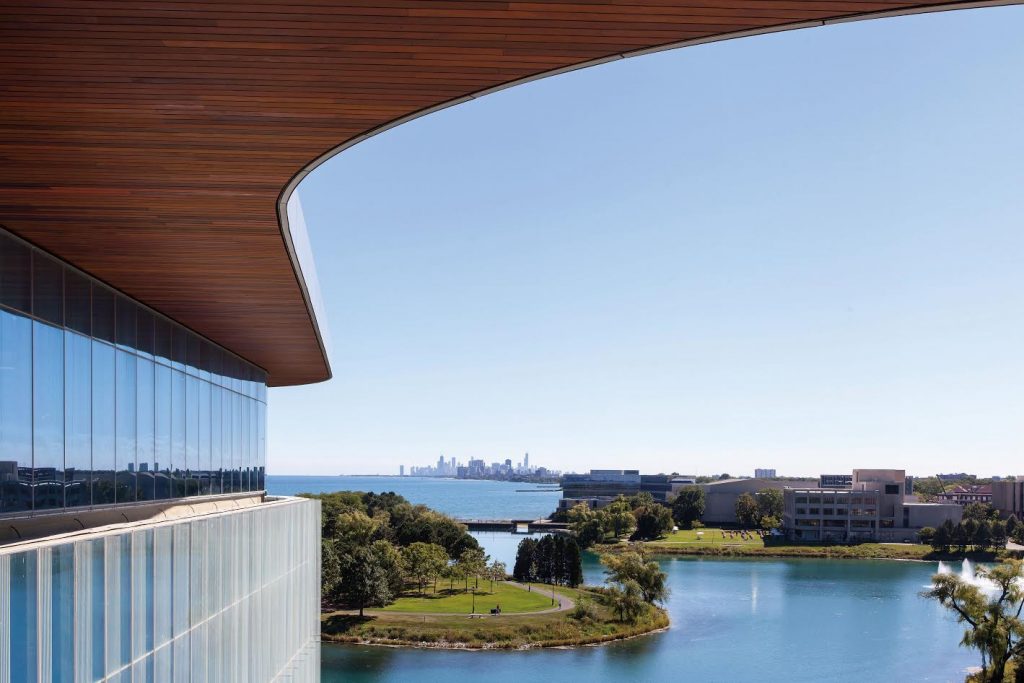Flexible Classroom Spaces Anticipate Evolving Teaching Needs
One of the most highly touted features of the new Global Hub is its flexible classroom space. In contrast to the Jacobs Center, which had almost exclusively tiered lecture rooms, the Global Hub features an array of different options that professors can choose from based on how they plan to teach.
“One thing we looked at was trying to right-size the rooms,” says Paul. “When we went back through several years of classes and looked at the number of students in each class, we realized you don’t need more rooms, you just need the right size rooms.”
In addition to the two large, side-by-side flat classrooms in the design wing—which are equipped with advance technology including cameras and ceiling microphones and can be combined to create an even larger space for conferences—the building features seven 50-person flat classrooms. Three of these smaller spaces can be made smaller still, split in half to provide the right space for more intimate seminar-type classes.
The flat classrooms feature flexible furniture on wheels that can easily be configured and reconfigured as classes break into smaller groups for project work. “Kellogg made a big commitment to go to flat-floored classrooms,” says Paul, noting that they make up roughly half of the classrooms in the Global Hub. These flat-floored classrooms complement seven 60-person tiered classrooms, more suited to traditional lecture-style teaching. Each seat in the tiered classrooms is equipped with a microphone that connects into a lecture-capture technology system, and two of the rooms feature advanced teleconference capabilities that provide for real-time collaboration across the globe.
Paul confesses that deciding how many flat- versus tiered-floor classrooms to build was something of a gamble. “It’s still kind of a guess because teaching styles are changing fairly quickly,” she says. So to maintain maximum flexibility, the rooms were designed to allow for changing from one configuration to another over the course of a summer. The walls, ceiling and technology are consistent in both the tiered and flat classrooms, meaning just the floor would need to be changed out.
Upper Floors House Faculty, Second Atrium, Spectacular Views
The third, fourth and fifth floors of the building’s four quadrants are devoted to faculty space, which Kellogg shares with the Weinberg College of Arts and Sciences economics department. Kellogg also shared space in the Jacobs Center with Weinberg.
A typical faculty quadrant features offices at the perimeter and shared space in the center. Each quadrant also has a light corridor—bringing sunlight into the more closed areas of the building from above—as well as a “floating” conference room that appears to be suspended above the shared lounge space.
“Kellogg wanted to break down some of the silos between departments,” explains Paul, which it did by horizontally mixing people at the boundaries and by stacking departments vertically around shared casual meeting places, where faculty can mix and mingle. Offices are a standard 165 square feet, suitable for one faculty member, two staff members or three PhD students. “Over time, you can easily move things around without moving walls, which was one of the goals,” Paul says.
Uniting the quadrants on the building’s upper floor is the second of the two stacked atriums, this one called the Faculty Summit. It ties together floors three, four and five and serves as the heart of the faculty space. Kellogg also opted to cluster its six seminar rooms around this area—which work well for teaching PhD students but also doubles as a symposium space the school can use to bring in outsider groups.
Crossing a bridge connecting the quadrants on the uppermost floors truly feels like walking on air—and spectacular views abound in all direction. Facing the question of who to put in the area spanning the two south quadrants—prime real estate with its birds-eye view of Chicago’s iconic skyline—Kellogg opted to make it an emeritus faculty suite. “Who better to get that space, with its great views in and out?” says Paul.










